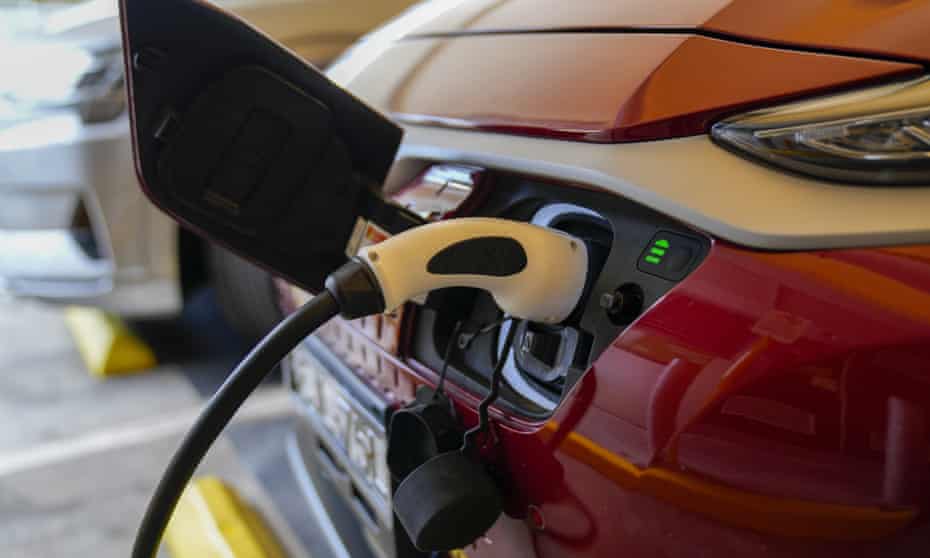What is the Morrison government’s electric cars policy – and will it actually drive take-up?
Scott Morrison says it’s about ‘choices, not mandates’, so what’s in and what’s left out of the Coalition’s EV and future fuels strategy?

First published on Tue 9 Nov 2021 01.59 EST
Days after returning from the Cop26 climate summit, the prime minister Scott Morrison has released his long-awaited policy on electric vehicles.
Morrison, who in 2019 said Labor’s EV policy would “end the weekend”, on Tuesday said his plan was “built on the back of the core principles. Technology, not taxes. Choices, not mandates”.
The release of the future fuels and vehicles strategy represents the first substantive announcement from the government on electric vehicles. So here is an introductory guide to what’s in it – and what’s not.
What has the government announced?
Under the plan, the government says it will spend $250m – including $178m of new funding as part of a future fuels fund – to build charging stations for heavy commercial vehicles, passenger cars and households. The strategy says this investment will “deploy charging infrastructure in over 400 businesses, 50,000 households and 1,000 public charging stations”. How it will do this is not explained.
Another “priority initiative” is encouraging governments and large corporates to buy EVs for business fleets. The plan states the Department of Finance is trialling battery electric vehicles in the government’s fleet of parliamentary Comcar vehicles and that hybrid vehicles make up 28% of this fleet. It says this trial will “inform the government’s future fleet purchasing decisions”.
What didn’t make it in
Under the plan there will be no phase-out timeline for petrol cars or targets for the take-up of zero emissions vehicles. The government says it will not introduce incentives to make it more attractive for people to buy EVs and it has ruled out introducing regulations that limit carbon dioxide emissions from vehicles.
The strategy is light on key details. For instance, the government is not clear about how it defines zero emissions vehicles, and at times appears to lump hybrid vehicles with pure-battery driven electric vehicles and hydrogen-electric vehicles together.
The “fleet first” strategy does not specify targets or timelines for government fleets that would encourage procurement officers to buy more EVs , and the government has only promised to “evaluate” the introduction of Euro 6 noxious emissions standards, which are part of a suite of regulations that ratchet up a vehicles engine efficiency up over time.
The Australia Institute’s Audrey Quicke said the strategy “shows us more what they’re not doing than what they are”.
“There’s not much new in this policy except for some charging infrastructure, which is welcome, but it’s a small piece of a thousand-piece puzzle,” he said.
Will the strategy drive EV take-up?
The government projects battery-electric and plug-in hybrid electric vehicles will make up 30% of new car sales by 2030, but has explicitly rejected the introduction of incentives to help people buy EVs and vehicle emissions standards to require a gradual shift to cleaner cars. It has not committed to the introduction of Euro6 standards on fuel quality.
While the greater availability of charging infrastructure is necessary to allow EV expansion, there is nothing in the policy to help lower the cost of the vehicles themselves and make them more attractive to consumers. More work on this is being done by the states, but some are better than others. New South Wales has been praised for initiatives under its own electric vehicle strategy, which offers $3,000 rebates for the first 25,000 EVs sold in the state and exemptions on stamp duty. NSW and Victoria both plan for 50% of new cars sold to be EVs by 2030, while Tasmania plans for 100% of new cars by 2030.
But will it cut emissions?
Based on electric and plug-in hybrid vehicles making up a third of all new car sales by 2030, the government projects carbon dioxide emissions to be reduced by 8m tonnes by 2035 – less than 2% of one year of Australia’s emissions. It is not clear how this figure was reached.
This is only a small dent in a large section of Australia’s national emissions. Transport is responsible for nearly 20% of national carbon pollution, and that share has grown steadily over time.
How does it compare to other countries?
While Morrison has stressed his government would not be “putting mandates on [Australians] and telling them what to do”, other countries have been setting dates to ban the sale of new petrol vehicles. Among the most ambitious are Norway and South Korea with plans to end the sale of new petrol and diesel cars from 2025. The UK will ban the sale of new petrol cars from 2030, and the sale of plug-in hybrid vehicles by 2035.
US states like California will phase out new petrol and diesel cars by 2035, and the Biden administration wants half of all new cars sold in the US to be electric by 2030. Meanwhile China, the world’s single largest car market, has plans to end the sale of petrol and diesel passenger cars by 2035.
